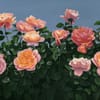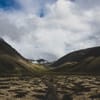What is the artist statement all about? When do you need it? And most importantly, how do you write one? In this article, we’ll answer these and other essential questions.
What is an artist statement?
An artist statement is a written description of your creative work. It provides context and background information and helps to clarify your intentions and artistic goals. An artist statement touches on your creative process, inspirations, and themes. It’s concise, clear, and reflective.
When to write an artist statement?
The statement introduces your work to potential buyers, galleries, curators, and other art world members. It’s an essential tool for:
Gallery exhibitions: When applying for gallery exhibitions or shows, curators and gallery owners will often ask for an artist statement to better understand your work and to see if it aligns with their mission and aesthetic.
Art fairs: For art fairs or festivals, you will often be asked to submit an artist statement to be included in promotional materials and for your booth space.
Artist portfolios: An artist statement can be a great addition to your portfolio, providing context and background information that helps clarify the thoughts and intention behind your work.
Artist websites: If you have a website, including an artist statement can help provide visitors with an in-depth understanding of your work and your creative vision.
Grants and awards: When applying for grants, residencies, or awards, you may be asked to provide an artist statement as part of your application materials.
Is an artist statement written in the first person?
Yes, the artist statement typically uses the first person, as it allows you to directly express your thoughts, ideas, and intentions behind your art and to communicate your personal connection to your work.
How long should an artist statement be?
There are no fixed rules that define the length of an artist statement. We recommend writing 1-2 paragraphs, or roughly 150-350 words in total, which allows you to express your ideas without overwhelming the reader.
Don’ts
Overuse technical terms or jargon: Avoid using International Art English even if you’re writing for a specific audience familiar with this style.
Be too personal: While reflecting on your experiences and perspectives is important, your statement should focus on your work and its themes rather than your personal life. Writing about yourself applies more to the artist bio, in which you focus on your creative journey.
Neglect to revise: Writing is rewriting. Read your statement several times and make revisions to ensure it represents your work and effectively communicates your ideas. It's also recomendable to seek feedback from fellow artists or friends who can offer a fresh perspective and may have suggestions you didn't consider.
Statements by Renowned Artists
- “I want to express my feelings rather than illustrate them. As long as something is said, it doesn’t matter how the paint is put on. On the floor, I am more at ease. I feel nearer, more part of the painting since this way, I can walk around it, work from the four sides, and literally be in the painting. When I’m painting, I’m unaware of what I’m doing. Only after a get-acquainted period do I see what I’ve been about. I’ve no fears about making changes for the painting has a life of its own.” – Jason Pollock
- “My work is inspired by the beauty I find in the small details of my own backyard. I focus on capturing the essence of nature through abstract forms and vibrant colors, drawing inspiration from artists like Monet. My creative process involves immersing myself in the natural world and translating those experiences onto canvas." –Michael Rich
- “I want the people in my pictures to stare back. I want to show exactly what my world looks like without glamorization, without glorification. This is not a bleak world but one in which there is an awareness of pain, a quality of introspection.” – Naan Goldin
- “By translating my hallucinations and my fear of hallucinations into paintings, I have been trying to cure my disease. I painted infinity nets daily; while doing so, the whole room appeared to have been covered with nets. So, I created pieces by covering sculptures with nets. I gradually feel myself under the spell of the accumulation and repetition in my ‘nets’ which expand beyond myself, and all over the limited space of canvas covering the floor, desk and everywhere.” – Yayoi Kusama
Crafting a well-written artist statement is an important step in establishing your personal brand and showcasing your work. By understanding your artistic vision, defining your unique voice, and presenting your work clearly and concisely, you can effectively communicate the story behind your art to a wider audience.
Remember, your artist statement should be an evolving document that changes and grows as your art and your creative vision evolve over time. So, take the time to reflect on your work and focus on your message.





